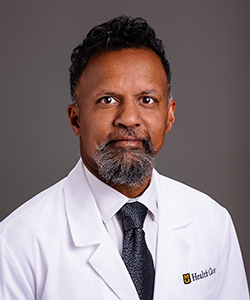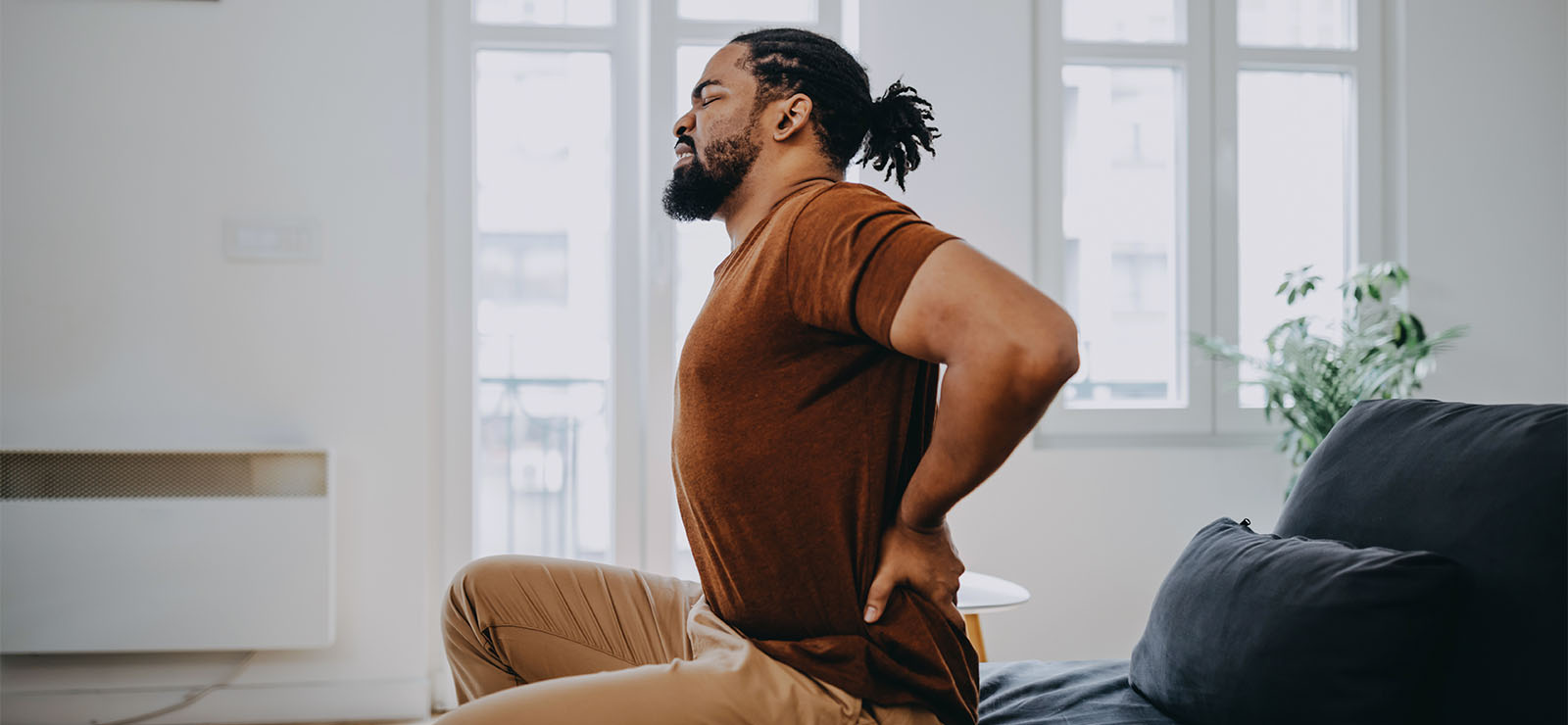April 23, 2025

After the candles are blown out on our 30th birthday cake, many of us start slowly (and sadly) checking off boxes associated with age-related changes. Found a grey hair? Check. Can’t read up close without glasses? Check. Need the subtitles to watch your favorite show? Check.
But while you might not expect back pain as early as your 30s and 40s, it can happen, and you shouldn’t ignore it.
“The more you just keep doing what you’re doing and ignore the pain, the more frequently it can occur,” says Dr. Ebby Varghese, an MU Health Care physical medicine and rehabilitation doctor who specializes in pain medicine. “In your 30s and 40s, you need to view back pain as a signal to protect your back health before you get any older.”
To guide you in preventing and managing back pain in your 30s and 40s, Dr. Varghese helps answer common questions:
Is Lower Back Pain Normal at This Age?
Nearly 40% of adults suffer from back pain, but — as you’d expect — the likelihood of it increases with age. More than 35% of people ages 30 to 49 report back pain.
Every person’s back pain is unique. Sometimes, lower back pain can be caused by an accident, serious injury or underlying medical condition. It may feel unbearable and include sharp nerve-associated pain that shoots down your butt and leg.
However, the majority (90%) of lower back pain is nonspecific. The pain may not appear to have an obvious cause and is not associated with a pattern of nerve pain, cancer or a fracture.

“Everyone has some type of back pain at some point. Most often, it’s nonspecific and resolves on its own,” Dr. Varghese says.
He adds that 25 to 55 is the most common age range for a disc herniation or bulge, which occurs when the soft center of a spinal disc pushes out of place. While aging can play a role in disc herniation, it can also occur with a traumatic injury (like a fall), repetitive bending or twisting, or lifting heavy objects incorrectly.
Unfortunately, these two decades can offer a perfect storm for a herniated disc — your body is aging, you may do a lot of bending and lifting (especially if you have young children) and sitting at a desk for work can leave you with a weak core. The good news is that your risk of disc herniation lessens later in life, when discs become thin and less likely to bulge.
What Causes Nonspecific Lower Back Pain?
Age plays a factor in back health — just as it does with your joints, hearing and skin. As you get older, your back undergoes changes:
- Discs lose water, and dehydration causes them to thin.
- Joints become arthritic after decades of activity.
- Spinal canal narrows (spinal stenosis) often due to bulging discs and arthritis crowding the space.
But age is not the only factor, and it’s much less likely to play a role in your 30s.
“Most people in their 30s and 40s are not at the point where those three factors are causing severe pain or requiring you to hunch over,” Dr. Varghese says. He adds that people in this age range are more likely to injure themselves or develop back pain after physical activity or labor-intensive work.
In addition, some people are more prone to back issues than others. Risk factors include:
- Being overweight, since your spinal discs carry 80% of the spinal load
- Congenital stenosis, which involves being born with a narrow spinal channel
- Family history, especially if a first-degree relative has chronic back pain
- Labor-intensive work involving a lot of twisting, lifting or loading
- Smoking, which decreases blood supply, lowers your pain threshold and advances spine degeneration more quickly
- Weak core, since your core muscles support your lower back
All these risk factors are important, but having a strong core is critical for back health. “If you have poor core strength,” Dr. Varghese says, “you’re highly likely to have issues.”
Many millennials (people in their late 20s, 30s and early 40s) grew up doing high-intensity training that doesn’t necessarily focus on the core. Even though you may have pushed your cardiovascular stamina and lifted weights, you may not have focused on strengthening the deeper abdominal muscles that protect your back.
“There are many reasons why someone could have nonspecific back pain,” Dr. Varghese says. “But in general, I think the most common reason is not consistently focusing on core strength.”
How Can You Prevent Back Pain?
If your parents have poor back health or have needed back surgery, you should be making lifestyle changes to avoid that fate. Not smoking and maintaining a healthy weight are good places to start. But strengthening your core is critical.
Dr. Varghese explains that we’re not just talking about working your abs. Your abs have three layers, and those muscles, along with your buttocks and low back muscles, create a cylinder that protects your back.
“If you keep that cylinder super tight, it actually lifts your upper body off your spine and you feel better,” Dr. Varghese says. “But most people don’t work on any of those muscles.”
You can strengthen those muscles by targeting your core for just 15 minutes a day, five days a week. You should see a significant difference in three months, but Dr. Varghese recommends making it a lifelong practice. He recommends exercises that target that core cylinder, such as:
- Bird-dogs
- Bridges
- Clamshells
- Pelvic tilts
- Planks
- Wall squats
If you’re stuck at a desk most of the time, Dr. Varghese suggests considering a sit-to-stand desk or sometimes sitting on an exercise ball — tilt your pelvis forward to avoid a slouched position.
What Can You Do if You Already Have Back Pain?
If your pain is acute following an accident or involves nerve pain, a back specialist may recommend imaging tests like a CT scan or MRI. But it’s not necessary for most general, nonspecific back pain.
“People with horrible-looking spines may have no back pain and vice versa, so for nonspecific pain, imaging won’t provide answers,” Dr. Varghese says. “The truth is, 90% of people get better within 30 to 60 days, even if your issue is a herniated disc.” You may need imaging if the pain worsens or doesn’t get better.
The best thing you can do, Dr. Varghese says, is respect the back pain. But that doesn’t mean standing still and waiting for the pain to pass — being sedentary after suffering nonspecific low back pain can lead to further weakness and pain. While you may not feel up to your normal daily activity or exercise routine, you should keep moving. Just recognize that you may need to adjust how you exercise. Choose low-impact activities, such as gentle stretching, riding a stationary bike or walking at a slow pace.
“Keeping a range of motion is critical, because it will improve your pain and help you recover faster,” Dr. Varghese says. “The worst thing you can do when you have acute episodes of low back pain is to do nothing. Rest it a little, but be as active as you can within your limitations and work on whatever strengthening exercises you can tolerate.”
How Can Doctors Help With Back Pain?
If you feel incapacitated or your pain is not going away, a medical provider may be able to help you manage the pain and guide you through recovery. You want to start with conservative measures first, Dr. Varghese says.
MU Health Care’s Spine Center offers a variety of specialists who communicate with each other to get you the right care. “The first steps include educating you, treating your acute pain and guiding you in gradually making lifestyle changes,” Dr. Varghese says. “But the end goal is an active and pain-free life.”
Conservative treatments they may recommend include:
- Prescription medicine, including non-opioid options, to relieve pain and inflammation
- Steroid injections, which typically provide a 50% improvement in pain levels for two to three months
- Physical therapy prescription, to help you safely strengthen the muscles surrounding your pain
“Once prescription medication or injections relieve the pain, use that time wisely and get started doing those things that are going to make you better,” Dr. Varghese says. “That way, if you experience back pain again, you’ll recover more quickly and tolerate the pain better.”
If needed, surgical interventions are a possibility. But surgery should be reserved for cases of debilitating pain when your provider identifies a specific problem and surgical solution.
Next Steps and Useful Resources
- Want to discuss more with a doctor? Request an appointment at our Spine Center.
- Want to learn more about care for back pain? Download our Spine Guide.


